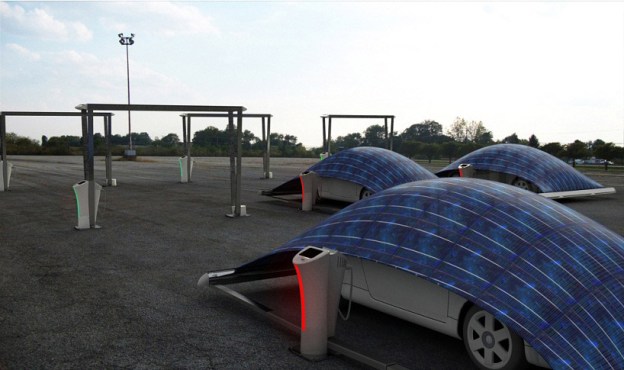
Whether you buy into the idea that alternative fuel sources are truly viable in the years to come, one thing is for sure: All that oil is going to run out someday, which is exactly why we must look to alternatives now. A number of car manufacturers are already hard at work solving this problem, but it’s going to take more than just automakers and legislation to drive us out of the oil age.
Enter Dr. Hakan Gürsu and the team over at DesignNobis. The small Turkish firm recently developed a rather clever EV charging concept called the V-Tent. While the V-Tent was designed to shield your vehicle from the Sun’s harmful rays, it doubles as a solar-energy gathering canopy for recharging an electric vehicle’s thirsty battery. We got in touch with Dr. Gürsu to get the lowdown on whether the V-Tent could solve some of our alternative fuel woes.
DT: The V-Tent is certainly a captivating concept. What was the inspiration behind its design?
The idea behind the V-Tent concept goes back to the many sunny summer days along the Mediterranean. Here, it’s hard to find a shade to park your car under, so we decided to develop a tent that protects the car, and produces energy at the same time.
What is the creative process behind developing such a concept?
Typically, the process starts with observation and then defining a problem. There were some criteria we wanted to follow for the V-Tent. For example, we wanted it to be collapsible, almost transparent in a way, when not in use. We decided that it needed to allow for both individual and public use. And it should be supporting technology and user interaction as well. Since we are focusing on ecological, energy saving products, we are keenly interested in solar energy. Our research team is following state of the art technologies and data, while our product development team focuses on design and engineering. There are also a number of different software used for production, animation, and simulation.

Even though the V-Tent is a concept, are there parts to it that are feasible now?
Feasibility of the V-Tent correlates to the EV market. In the U.S. and Europe electric cars are becoming widespread.
Could the technology be modified to be on-board, so EVs could drive with the tents “folded” up and then deployed anywhere when a charge was necessary and sun was available?
It may decrease aerodynamics, increase weight and costs. Our aim is to solve the problem more for public use and maximum efficiency with less initial investment.
What are some advantages of the V-Tent?
There are a number of advantages: Your car is safe and protected from environmental effects, and it’s getting charged at the same time. Also, public usage enables easy access since you can charge your car where you park it. Our concept system also has a simple interface with charging time information and payment options built in.
Are you in talks with any companies to develop a working model?
The V-Tent concept has been honored with the 2012 Green Dot Award, and we plan on entering new competitions, too. There are some offers we will be discussing; however, a low-tech version can be readily built with advertisement on textile instead of solar panels. That would also work as ad income for system installation.

Do you think electric vehicles will replace gasoline-powered cars any time soon?
Since petroleum resources are limited and already 30-35 percent is used in plastics production, and one kilogram of oil consumption has a price of 3.5 kilograms of carbon dioxide, alternative energy resources will be gaining more and more importance. We believe that vehicles with alternative energy usage will become widespread, especially with new regulations and ecologic considerations.
Where do you see the V-tent being the most effective?
It really depends on some criteria, such as environment, car usage and distances. Also government policies are important. Recently, there have been new regulations in the European Union and clean energy strategies are being developed in favor of electric cars and charging points as well.

How long did the entire creative process take?
It took about 12 months with changing work load.
Moving along to a slightly different topic, what is your favorite electric car at the moment?
As a group of product designers, some of us are really into cars. Tesla seems the overall favorite among our office – mostly for its design, technology, and emotional aesthetic.
What is your least favorite?
The Fisker Karma is our least favorite in terms of efficiency.
Are you working on any other automotive-related projects?
Last year we designed an electric car concept called the Phaeton, which we developed for Istanbul, especially for the old town area where streets are quite narrow and small taxis are needed for sightseeing. The Phaeton’s overall design was a response to the need of intercity, low speed cars. For classification purposes, it slots between automobiles and non-motorized vehicles, and was designed in accordance with international vehicle norms defined as weighing less than 250 kilograms and traveling no more than 40 km/h speed. It is especially suited for low speed areas such as inner-city alleys, historical or tourist areas, and university campuses, and was honored with the Silver Award in the A’ Design Award Competition held in Milan.
Thank you again for all your time and effort.
Thank you for your interest.
Editors' Recommendations
- This EV charging tech does the job as you drive
- New battery design could mean EVs charge in only 10 minutes


